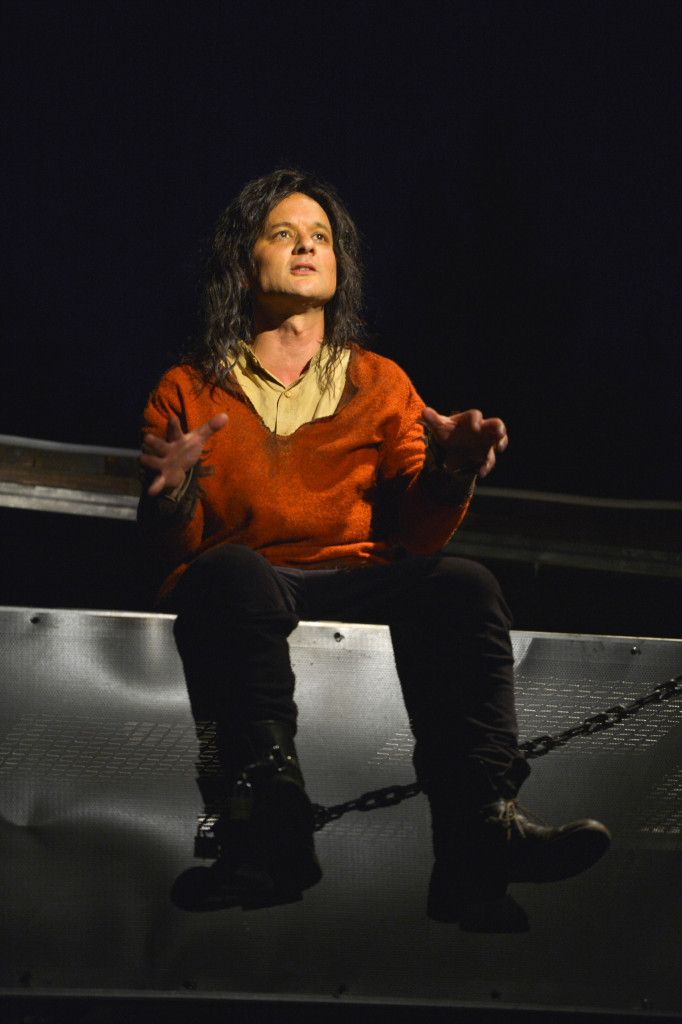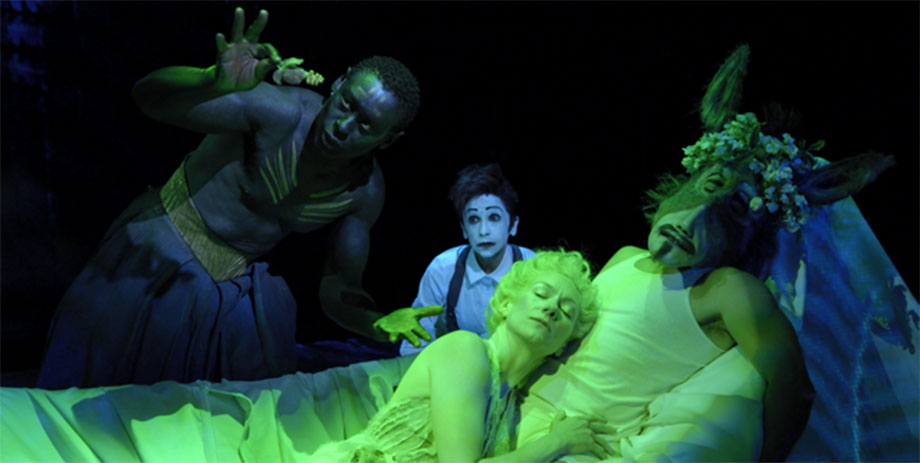Comedy and Emotion: A Review of THE LIAR at Santa Cruz Shakespeare
July 28, 2015 § Leave a Comment
“Emotion and comedy are enemies,” wrote the great French philosopher Henri Bergson, in a famous essay on humor. Santa Cruz Shakespeare’s beautiful, but strangely heartless, production of The Liar (adapted by David Ives from French neo-classic author Pierre Corneille, who in turn had adapted it from Spanish Golden Age writer Juan Ruiz de Alarcón y Mendoza) is a study in how difficult finding balance can be. There are some terrifically funny scenes in this very pleasant comedy, but the overall effect was oddly cynical about both love and honesty.
Neoclassic Comedy in “Transladaptation”
Since its premiere in 2010 at the Shakespeare Theatre in Washington, D.C., which commissioned this loose translation/adaptation, Ives’ version has become a staple of the Shakespeare Festival circuit. (In the Bay Area, Marin Shakespeare performed it in 2012, in a well-reviewed production I did not see. The following year Livermore Shakespeare Festival performed a version that, as I said in my review, I found charming.) Ives plays with language amusingly in a witty, anachronistic iambic pentameter version that tells the story of a young rake-on-the-make, Dorante, who is perpetually incapable of telling the truth and his hired servant, Cliton, who is equally unable to tell a lie.
Ives is, of course, a well-known playwright of absurdist-flavored comedies of his own devising, especially Venus in Fur – and his screwball rhymes, silly puns, and sly insertion of contemporary observational comedy explain exactly why the Shakespeare Theatre chose him to create this new version of The Liar.
It is Better to Look Good than to Feel Good (Or Is It?)
In Santa Cruz, Nina Ball’s beautiful set, essentially consisting of life-sized black-on-white architectural renderings, and David Mickelson’s elaborate period costumes created a gorgeous spectacle. (I saw an afternoon performance in the outdoor redwood glen SCS uses as its current performance site where Kurt Landisman’s lighting design was not readily discernible, but I have yet to see a design of his that I did not admire.)

Toby Onwumere (Cliton), Brian Smolin (Dorante), and Mary Cavett (Clarice) in David Mickelson’s costumes. All photos by Shmuel Thaler.
Much of the action is farcically mechanical, and when that is the case (like the comings and goings of “a set” of identical twin serving maids with opposite temperaments, played to great effect by Melinda Parrett), Art Manke’s direction is meticulous. Fight choreographer Kit Wilder created a terrific mock duel involving imaginary rapiers that extended that precision from the ridiculous to the hilariously sublime.
More than a Farce
The play is more than a farce, however. Our lying hero, Dorante, is using his talent for prevarication to pursue a young woman who has caught his eye, and in the manner of romantic comedy that leads to an eventual love match. In this case, however, too much comedy becomes the enemy of emotion. It is hard to root for Dorante, or at least Brian Smolin’s chipper but strangely charmless rendition of him because, while his flippant self-absorption got the verbal antics right, it created little empathy. The young woman – or as soon becomes apparent, women – who so entrance him were played by Sierra Jolene and Mary Cavett with wit and verbal dexterity, but as so calculating that it is hard to identify with them, either.
As I observed about Santa Cruz’ other offering in the current repertoire, exploring the callowness of youth does not an evening make. In their outstanding production of Much Ado About Nothing, an engagingly emotional supporting cast provides depth that the youthful leads cannot. There is much less opportunity for such humanity in Ives’ play, but even Kurt Meeker, as Dorante’s long suffering and endlessly forgiving father, stays in key with the rest of the production by playing the part with an emotional distance at odds with the sentiment implicit in the script. The cumulative effect is chilly. When the clever resolution is finally reached, although amusing on a surface level, it is hard to care, and not even clear that it is a good thing.
This peculiar outcome is partially the result of the artificiality of the elevated playing style, partly because of the mask-like quality of the exaggerated make-up, but mostly because the emotional depths of the narrative are left unplumbed. The essential ingredients are all there, but as in a soufflé, it requires delicate handling to makes it rise. The good news is that there is plenty of time left in this run for this gorgeous production to find its emotional balance.
The Liar by David Ives
Playing through August 29, 2015
Seen on July 25
Smart Choices, More Voices: A Review of MUCH ADO ABOUT NOTHING at Santa Cruz Shakespeare
July 26, 2015 § 1 Comment
Mike Ryan is making a lot of smart, invigorating decisions as Artistic Director at Santa Cruz Shakespeare, but the smartest of all might be to feature his own talents as Benedick in their current production of Much Ado About Nothing. He is an exceptional actor, generally under-utilized in dazzling cameos and featured side-kick roles. He is evenly matched by the wonderful Greta Wohlrabe, who was outstanding last season in the secondary roles of Mistress Page in MWW and Celia in AYLI, and is even better now when she is promoted to the central role as Beatrice. Character actors are placed front and center – and celebrated – throughout this production, with the famously quarreling couple masterfully mining the text for both humor and emotional nuance.

Mike Ryan (Benedick) and Greta Wohlrabe (Beatrice) in Santa Cruz Shakespeare’s Much Ado About Nothing. Photo by rr jones.
Rosie the Riveter Revisited
Under the direction of Laura Gordon, the production is set just as the troops return from WWII, with strong Rosie the Riveter-type women tending what appears to be an idyllic California vineyard. (More about those women later!) Nina Ball’s minimalist set and B. Modern’s costumes gave the show a postwar flavor that was never really foregrounded (at least not in the way that a similarly situated Taming of the Shrew at Livermore Shakespeare Festival utilized this tension a couple of seasons ago) but made perfect sense as a background. The gorgeous lighting is by my SFSU colleague Ray Oppenheimer, and Kurt Landisman.
The challenge of Much Ado is that the protagonists – a young Count Claudio and his intended bride, Hero – are not particularly large or compelling parts. Josh Saleh and Sarah Traisman are more than competent in these roles, but exploring the callowness of youth does not an evening make. The energy of the show must come from the supporting characters, particularly from Beatrice and Benedick who have to run the gamut from farce to border-line tragedy. A silly set of clowns also invigorates the proceedings (and provides the actual solution to the plot crisis, albeit accidentally).
Range and Virtuosity
Ryan and Wohlrabe find the complete range of tones in their characters. Both are pleasantly humorous in their farcical scenes but really come into their own when revealing the darker content. They handle the language beautifully, making the text accessible without compromise, but what ultimately makes this a moving and inspiring evening is that they are willing to explore their own emotional vulnerabilities in ways you rarely see in comedy.
Steve Pickering accomplishes a similar virtuosity, although he does it by playing a pair of contracting characters rather than revealing the range of a single one. His sinister Don John, the antagonist of the play, is coldly chilling but by the addition of a pair of glasses and a thick, hick dialect he becomes the hilarious constable Dogberry.
Another source of interest in the evening stems from Ryan’s decision as AD that the organization should try to achieve gender parity in its casting. Because the casts of Shakespeare plays are far from evenly balanced with male and female roles, that involves some careful decisions about how to deal with the mismatch between supply and demand. It is possible for women to simply put on pants and play the male parts (a decision employed by SF Shakes last summer) but Director Laura Gordon settled on prominently regendering the roles of Hero’s father and uncle – Leonato and Antonio become Leonata and Antonia. This is not just a matter of switching pronouns, however. In a play with a plot that so thoroughly incorporates traditional gender roles and male privilege, the resulting shift in perspective could unsettle the balance.
Particularly at the moment of crisis, when Hero’s parent turns on her after Claudio rejects her at the altar as unchaste, only an artist of fierce intelligence and exacting specificity could make that plausible as a mother’s psychological shock rather than a father’s loss of property and “honor.” Fortunately, Patty Gallagher is such an artist. Although known locally for her almost ditzy comic turns, she is both smart and brave, and in this production she totally “goes there.” Backed up with equal strength by Suzanne Sturn as her sister, the about-faces of the characters became not just more plausible, but actually more compelling when they finally do the right thing and confront the callow count and his misogynistic enabler, Prince Pedro. It is worth seeing this production just to watch these two women reinterpret these roles.
Much Ado About Nothing
Playing through August 30, 2015
Seen on July 25
Taymor’s film of MIDSUMMER announces additional showings in NYC, and around the US
July 26, 2015 § Leave a Comment
Three additional New York showings of Julie Taymor’s film of her theatrical production of A Midsummer Night’s Dream have been announced. The first is this Thursday, July 30.
Full information is available here.
I reviewed this film earlier. My review is available here.
Additional showings around the country are available at this location.
A Woman’s World: A Review of AS YOU LIKE IT at the Livermore Shakespeare Festival
July 21, 2015 § Leave a Comment
If this season is the “Year of the Woman” among Bay area Shakespeare Festivals then surely the Livermore Shakespeare Festival, with its female leadership team (Artistic Director Lisa A. Tromovitch, Managing Director Katie Marcel) deserves particular notice. Although they have done nothing to draw particular attention to it, it is worth observing that this summer the festival has an all-female directing staff (Tromovitch and long-time company member Jennifer Le Blanc) and a female-centered repertoire (Sense and Sensibility, As You Like It).
[Note: Managing Director Katie Marcel has pointed out that, although she describes it as a matter of chance and not design, the Board of Directors is also all-female.]
Women Leading
The company is certainly on the move. Tromovitch is the recently elected President of the International Shakespeare Theatre Association and has worked steadily to raise the profile and professionalism of her company over the last five years, including a change for this season to Wente Vinyards as a performance venue.
That new venue provides the key to Tromovitch’s production of As You Like It. Performed on an elevated platform with essentially no scenery and completely surrounded by the audience, the opening night performance had an unforced rapport between the performers and the audience reminiscent of the original conditions for Shakespearean performances. The audience was very close, and never treated as if they were in a separate space. It helped (a lot) that no matter where you sat, audience members were in your direct line of sight across the stage from you. Actors freely passed through the audience for ALL entrances, and those not currently onstage frequently popped into empty seats here and there to watch the show with us.

Michael Wayne Rice as Jacques and the cast of As You Like It.
Costumes by Barbara Murray.
Photo by Gregg Le Blanc, CumulusLight.com.
The resulting casual tone was perfect for just knocking back and enjoying the show, aided by the fact that nearly everyone there was enjoying a glass of wine while they watched. The comfort and ease of the audience interaction was a stark contrast to most Shakespeare, indeed most theatre, that I see where the audience is strongly controlled and subtly intimidated. Here, it was easy to forget that you were watching a four hundred year old play by the-greatest-writer-that-ever-lived. It felt as easy going and enjoyable as a community picnic.
Tromovitch’s take on the show was essentially conservative, with period-ish costumes with a folk flavor designed by Barbara Murray, although she did adopt a very original approach to the dramaturgically troubled ending of the show that surprised and delighted. Her point, however, was not to comment on the show but to fulfill it. Thanks to leading lady Maryssa Wanlass, it was the most emotionally present and engaging AYLI I have seen in some time. Her chemistry with Joseph Salazar (as Orlando) was as fresh and delightful as that of the latest summer rom-com.
A Fiendishly Difficult Favorite
As You Like It is a popular favorite among Shakespeare’s comedies, but is in fact fiendishly difficult to get right. It employs the most music of any Shakespeare play, has a rather unfocused, meandering plot, and typically ends with a literal, and essentially unexplained, deus ex machina in which the god Hymen arrives to set things right – an incident treated so casually that one might assume these characters just interact with gods daily. Things can, and often do, go wrong on all three fronts.
Tromovitch tackles all three of these challenges with a single unifying device – the continual foregrounding of singer Sean Patrick Nill as a kind of metatheatrical narrator. In his hands, often accompanied by other cast members vocally and on instruments, the music is aesthetically engaging while used to tie the story together. When he subsumed the role of Hymen at the play’s end – because he had seemingly been manipulating the story from slightly outside and above the play all evening – it, for once, made sense!
Layers of Plot
The plot is complicated: a dispossessed young man, Orlando, falls in love with the beautiful niece of his corrupt Duke, but is so green and awkward he falls back on clichéd love poems to woo her. The niece, Rosalind, is herself forced to flee from her uncle, who usurped the crown from her father. To protect herself, she goes into exile disguised as a man. They meet again in the woods where both have fled. Orlando does not recognize her through her male disguise, but agrees to some tutoring from her (in her male persona) during which s/he will imitate his beloved for him in a role-playing exercise. At the center of the play is a scene in which (in the original, a boy-actor playing) a woman who is disguised as a man pretends to be a woman (in fact, herself) in order to teach her leading man how to be more genuine and assertive. It is a feat of real skill to keep all these levels clear – especially when the characters get them confused. Tromovitch handled this scene as cleverly as I have ever seen it, with Salazar’s befuddled Orlando becoming increasingly confused about who, exactly, he is falling in love with – the girl or the boy.
Things work out predictably for the couple, and for several other couples that provide variations on the theme in a series of related subplots, but not until the inevitable ending has been delayed as long as possible by the loose diversions found in a summer paradise.
It takes a lot of work to make this all happen but Tromovitch achieves it all with such a light touch that her direction is essentially invisible. Looking back, the engaging evening flew past but felt as indulgent as a chocolate truffle. Strong performances from Patrick Andrew Jones as Orlando’s reforming older brother, William J. Wolak as his faithful servant, and Lindsey Marie Schmeltzer as an overly proud local yokel who falls in love with Rosalind’s male alter ego proved high points.
The cast was not universally strong, which showed particularly in some unconvincing doublings that were neither executed with versatility on their own terms nor justified in their undisguised reuse of actors by a performance convention. Also, as is often the case, some of the more dated farcical parts of the play that have lost their point over time became strained searching for a laugh.
The performance had far more strengths than weaknesses, however. It was a perfect match of venue and play – a light midsummer comedy in an intimate, casual park-like setting. Only the hardest of hearts could possibly resist the swift and glorious ending.
A Company to Watch
Perhaps it is assuming too much to think that the marvelous sympathy between directorial approach and the leading actress’ strengths has anything to do with their shared gender. Maybe it is just Tromovitch’s directorial skills, and not her particular insights into this woman-focused play, that get the tone of this intricate comedy so right. Conceivably, the particularly invitational, friendly environment established in the new venue is the product of good audience engagement research and has nothing to do with the sensibilities of an all-female management team. It is worth contemplating, however, whether more than coincidence is at work. Let’s keep our eye on Livermore Shakespeare Festival to see if women’s leadership continues to provide unique results!
As You Like It
Livermore Shakespeare Festival
Through August 2, 2015
Wente Vinyards, Livermore CA
Seen: July 17, 2015
Dreaming of a Better World: A Review of LIFE IS A DREAM at CalShakes
July 12, 2015 § Leave a Comment
Attending the live theatre can be fun, intriguing, informative, provocative, entertaining, educational… but what keeps me coming back show after show is that every once in a while everything aligns and a night in the theatre is just magical. Such is the case with CalShakes’ beautiful, lyrical production of Calderón de la Barca’s Life is a Dream directed by the brilliant Loretta Greco.

(Above) Carlos Berrera and Kaiso Hill; (below) Sean San José as Prince Segismundo in California Shakespeare Theater’s Life Is a Dream, directed by Loretta Greco; all photos by Kevin Berne.
Anything but Dry
Finding the heart of this Siglo de Oro (Spanish Golden Age) masterpiece is not easy. Usually called a “philosophical drama,” it is, on the rare occasions when is performed, often cold and mechanical. The opposite was the case here. Pulitzer-prize winner Nilo Cruz’ (Anna in the Tropics) translation and adaptation was a key to capturing the shimmering other worldliness – that quality that was later to be called “magic realism” – that permeates the original, but seems so elusive in English.
(That the drama of the Spanish renaissance is so shamefully neglected on the stages of Shakespeare festivals – despite the fact that here on the West Coast a plurality of the population is of Hispanic heritage – especially when French farce is such a staple, is a rant for another day. For now, let me just honor Artistic Director Jonathan Moscone’s opening night statement that it is exceptionally difficult to find the right artist to “unlock” these plays. Greco is absolutely the right artist!)
A Son Betrayed
La vida es sueño tells the story of a crown prince, Segismundo, imprisoned and isolated from birth because ill-omens suggested he would become a oppressive tyrant and overthrow his father, who is drugged and brought to court for one day as a test before one of his cousins is named heir in his place. It is a test that he fails miserably, having known nothing but a brutish, caged existence. The tiny bit of education and philosophy given him by his sole caretaker, a nobleman named Clotaldo, cannot steer him through his first encounters with luxury, power, and especially with the lust he feels when he encounters women for the first time. After a disastrous day, he is again drugged and returned to his cell, where he is led to believe that it was all nothing but a dream. Clotaldo suggests that what he can learn from his “dream” is that it is important to strive for goodness and mercy at all times, even where it seems one has no control.
Segismundo’s existence having become known, however, sets off a civil war and he is freed by his people who refuse to accept the rule of the foreign-born cousins. Now unable to distinguish what is real and what is imaginary so reliant only on pure principle, Segismundo successfully leads the rebellion and conquers the father that has so painfully betrayed and abandoned him, leading to a stunning final encounter.
Otherworldly Beauty
Cruz’ translation and Greco’s production set this story indefinitely in both time and space. Andrew Boyce’s graceful set is a single platform that spirals into the sky above a plain metal box that serves as a cell. Guns and steel suggest the time is not “then,” while capes and swords suggest that it is also not “now.” No geographical references occur at all. Alex Jaeger’s vaguely period costumes and the crystalline illumination by Tony-award winning light designer Christopher Akerlind create a world that is both accessible and ephemeral.
Greco does not make any contemporary references explicit, but the inescapable parallels to repressive regimes, betrayed generations and the seeming unreality of much of modern life float forward anyway. A light touch has a huge impact.
Stunning Cast
Segismundo is usually played by a Hamlet-like tragic hunk, but the revelation of the night was the extraordinary central performance by the man-child Sean San Jose. His simple awe at everything he encountered coupled with his quick, deep connection to his emotions made his transcendent performance moving beyond description.
The moral center of the play is Clotaldo, caught between loyalty to his king and his duty as caretaker to Segismundo. Julian López-Morillas, an artist with long and deep ties to this community, brought to the role the same intensity and humanity that illuminated his revelatory performance as Geronimo in Marin Shakespeare’s The Spanish Tragedy two seasons ago.
Performances of the play usually fall apart around the tangential sub-plot about a young woman seduced and spurned by Segismundo’s cousin, Astolfo. Never having known her father, and unable to find any champion, she sets off in male disguise and with a comic side-kick to seek revenge, where she encounters Segismundo in his prison and eventually finds her real father and her destiny. Even bravura performances often fail to make the role rise above the improbability and coincidence.
In the hands of Sarah Nina Haydon, however, this Rosaura becomes something else. She finds her own suffering parallel to Segismundo’s, not least because of the way that it keeps intensifying through circumstances that she experiences as surreal. Her life is as nightmarishly dreamlike as is the protagonist’s, and as revealed by the delicate handling of her performance under Greco’s direction, as ours.
The cast is uniformly superb. Amir Abdullah is charismatic as the complex cousin Astolfo. Company favorite Tristan Cunningham has never been better utilized than she is as the radiant competing cousin Estrella. Adrian Roberts is a commanding presence as the conflicted king. Jomar Tagatac is by turns hilarious and then devastating as Rosaura’s pragmatic side-kick. Even the unnamed parts were fulfilled brilliantly by Carlos Barrera, Kaiso Hill and, especially, a compelling Jason Kapoor – whose reappearance in multiple roles rose above utilitarian and became yet another element that made the production feel dreamlike.
Another Dream Play
When the play finally reaches its climax, with the conquering Segismundo facing down his self-serving father, honest but inadequate tutor, love-interest who is in love with somebody else, and scheming cousins, the adaptation by Nilo Cruz takes an unexpected turn away from the predictably mundane resolution of the plot and leaps into the poetic heights reminiscent of Shakespeare’s dream play, Midsummer. It is a gasp-inducing conclusion that feels perfectly suited to the cultural moment. Theatre does not get better than this.
Life is a Dream
Playing through August 8, 2015
California Shakespeare Theatre
July 11, 2015
Forgiveness After All: A Review of CYMBELINE at Marin Shakespeare
July 4, 2015 § Leave a Comment
Shakespeare’s brilliant but rarely-produced gem, Cymbeline, is receiving a wonderful new staging by the Marin Shakespeare Company (with a terrific new musical score by Billie Cox) that makes you wonder why this play is so rarely performed.
Tales of Reunion and Redemption
Cymbeline is one of Shakespeare’s four late tragicomedies, collectively known as the Romances. (The others are The Tempest, Pericles and The Winter’s Tale.) Their essential quality is the way in which they seem to shift genre as they progress from darkest tragedy to hard-won, but happy, endings.

The full cast on Jackson Currier’s evocative set for the revelatory final scene. All photos by Lori A Cheung
The titular character of Cymbeline is the king of Britain during the time of Caesar Augustus, but he is a relatively minor character in the play. The protagonist is his daughter, Imogen, a role with such range and variety that it is known as the female Hamlet.
Enough Plot for Ten Plays
The plot is enormously convoluted, even by Shakespearean standards, but essentially traces her fortunes after she marries (over her father’s, and especially her wicked step-mother’s, objections) her poor-but-valorous childhood sweetheart, Posthumus, in preference to her cloddish step-brother, Cloten. For ruining Cloten’s path to the kingship, Posthumus is banished, makes his way to Rome, and in a self-pitying drunken episode is persuaded to wager on his wife’s fidelity. Through the trickery of a Machiavellian villain named Iachimo, he is convinced that she is unfaithful to him, so he puts a hit out on her.
Meanwhile, she secretly travels to Wales, where she believes she will be reunited with Posthumus. Once informed by a sympathetic servant that she has been lured there to be murdered, she goes into male disguise and falls into company with a long-banished courtier (now gone Celticly native) and the two young men he is raising as his sons. After additional plot twists and turns, she awakens from a Juliet-like artificial coma to discover a headless corpse next to her dressed in her husband’s clothes, at which point she has a famous freak-out scene. Against the background of a battle between the native Britains and the occupying Roman Legions (who have conscripted both Posthumus and Iachimo into their service) the circumstances are aligned for all to work out, but no character has access to all the facts.
The play ends with a wildly improbable, and therefore wondrous, final scene consisting of some thirty+ revelations, as individual characters slowly realize they know a crucial piece of information and steadily trump each other with escalating plot twists that take in deathbed repentences, mistaken identities, long-lost children, and finally (beautifully! magnificently!) forgiveness and reunion.
Marin’s version is streamlined, shortening one of Shakespeare’s longest plays into a comfortable two-and-a-half hour playing time. Some presentational moments of paraphrase of plot points apparently thought too obscure were unnecessarily colloquial, coming off as condescending instead of comic, but they did get us moved on to the meat of the show.
Overlooked Masterpiece
Cymbeline is shamefully neglected and under-produced, historically because plays with female protagonists were thought, incorrectly, to lack drawing power – ironically the very same debate currently raging over Hollywood blockbusters. At the moment that tide was finally beginning to turn, the sheer demands of size and scale of this enormous play began to make it undesirable in the increasingly impoverished circumstances of the American theatre. Marin Shakespeare, the little-company-that-could, is far and away the most programmatically adventurous in the Bay Area and seems completely undaunted by either threat.
As Imogen, Stella Heath brings the range and the stamina the part demands, along with an enormously sympathetic appeal. She is the glue that holds this production together, and is a great standard bearer for Marin in what is turning out to be “the summer of women” at Bay Area festivals. Thomas Gorrebeeck pulls off the theatrical tour-de-force of playing both the hero, Posthumus, and the antagonist, Cloten. His Posthumus is suitably hunky and believably gullible, diametrically contrasting with his rather unnuanced portrayal of the nuance-free dolt, Cloten – but scores the most memorable moment in the production when (in an incongruously inserted rock song) he proves he has the moves like Jagger.
The cast has several other standouts, including Davern Wright as the smarmy, and then astonishingly guilt stricken, Iachimo; Rod Gnapp in the wildly difficult role of the courtier-turned-mountain man Belarius; and the amazing local favorite Debi Durst, who may have the most expressive face in the Bay Area, and without whose astonished range of reactions in the final scene we might have been totally lost.
Billie Cox has added a set of original songs, using Shakespearean lyrics, with a generally pleasing Celtic quality that seem both authentic and efficient. (A few less impressive modern digressions were not to my taste – the most egregious of which was the insertion of “That’s Amore,” with both original lyrics and then a reprise with a set of juvenile alternative lyrics that fell flat, but those moments passed quickly while the impact of some lovely ballads and love songs lingered.) Jackson Currier’s set is the best that this generally spectacle-eschewing company has utilized for years, and Tammy Berlin’s costumes are more than serviceable.
Transcendence After All
Robert Currier’s direction was generally sound and inventive. The opening expositionary moment of the show, usually a dull recitation of facts, featured a stroke of genius: the staging included a bed rolling across the stage as its inhabitants (Imogen and Posthumus) were introduced. He also moved huge crowds about the stage, not just efficiently, but in ways that pictured the complex story clearly.

Davern Wright as the Machiavellian Iachimo after having smuggled himself in Imogen’s bedroom in a trunk.
His control of tone was shakier, as he seemed particularly concerned not to let the early parts of the show become too serious although their tragic threat is exactly what makes the final dodging of death and destruction work. As a result, many of the antagonists seemed comic stereotypes instead of credible obstacles. The real loss of the evening is that the combat, staged by Richard Pallaziol, seemed under-rehearsed and amateurish compared with the rest of the production.
However, whatever quibbles I have with the progress of the show cannot diminish the overall accomplishment, especially the transcendent final scene. With the still-stinging pain of Charleston on our minds, one could not help but think of the powerful moment of forgiveness offered by those grieving families when Posthumus – faced with similar villainy – uttered the beautiful line, “Kneel not to me./The power I have on you is to spare you,/The malice toward you to forgive you. Live,/ and deal with others better.”
Cymbeline
July 3 – 26
Marin Shakespeare Company
Seen July 3, 2015
Julie Taymor’s A MIDSUMMER NIGHT’S DREAM: a review of the film
July 1, 2015 § 1 Comment
Julie Taymor’s acclaimed production of A Midsummer Night’s Dream for Theatre for a New Audience is now available in a fascinating new film, and it is well worth seeing both for her ideas about the play and about plays on film.
A Play and a Film
Because MND is so much about the theatre itself, it is not a surprise that Taymor has eschewed the location shoots she adopted for her previous Shakespeare films – Titus and The Tempest. This film records her production inside the theatre where it was performed live, capturing the visual splendor and relentless inventiveness for which she is known, but it is quite different than the relatively static live broadcasts of plays for which Britain’s National Theatre has recently become known. Taymor uses a lot of filmic techniques. Cameras on stage capture the action from extremely close distances and viewing angles that no live audience member could ever experience, and (especially at the beginning of the film) the cameras are so active as they quickly pan around the crowded stage that they give the impression of being active participants. At other times the camera becomes such a close confidant of the actors, especially David Harewood as Oberon, that the style of the acting shifts to the whisperingly cinematic.
Occasionally you get a more traditional view of the stage, usually when Taymor is recording the interaction of actors and the extraordinary projections on floating silk banners and canopies that astounded the live audiences in Brooklyn. As impressive as these shots are, this alternation between the conventions of film and theatre is sometimes disconcerting.
Kathryn Hunter, Genius
Both the production and the film are completely built around the performance of the remarkable Kathryn Hunter as Puck. She opens the film as an exhausted sleeper drifting off into dreams, and when the rude mechanicals (as modern dress Brooklyn construction workers) show up and cut her bed free she literally drifts into the grid above the stage like a balloon. Her first full scene, with what is ordinarily a single fairy but is here a full cast of children who sing and chant the scene, establishes her distinctive childlike voice. Her wide-open wonder plays especially strongly in her scenes with Oberon, where she idolizes him like a parent–sometime fearful and sometime delighted to be pleasing him. It is the most fully imagined and realized Puck I have ever seen. For her performance alone, the film is worth your time.
The film is not without theatrical and cinematic flaws. Taymor is frequently more concerned with the big picture than the detail – and almost always prioritizes the visual over the auditory. The sound appears to have been captured through body mics, but sometimes you hear the faint echo of an additional actor’s mic. Often the scansion is sloppy. (At one point the possessive form of Theseus’, which should be two syllables, thes-yus, is rendered as four: Thes-e-us-es!)
Multiethnic and International
The production is especially interesting in the realm of the supernatural, where Taymor’s visual genius prevails, while the “real” world is more mundane. Unfortunately that is not just because the visual presentation is more restrained. It seems the interpretive act was just less interesting to Taymor. The lovers were trivialized, with only Mandi Masden as Helena making an impression, and the admirably multiethnic mechanicals were largely conveyed through broad stereotypes. Max Casella was amusing as a Brooklynese Bottom, but (as is often the case) Flute steals the show from him. In this case it is Zachary Infante’s Spanish speaking Francisco Flute that unlocks the wonder of Shakespeare’s power, as he discovers the ability to invest words he scarcely understands with meaning and power.
The most interesting casting of the evening is Okwui Okpokwasili as the conquered Queen Hippolyta. Both the gender and racial politics of the part were treated lightly, but her powerful presence was more than enough to make the point.
Finding the right level for a film of a play is a complex task. This relatively complete production of the script is FAR more satisfactory than Michael Hoffman’s disappointing, choppy 1999 film, and in many ways is also more pleasing than Adrian Noble’s similarly mixed film/play (1996) of his RSC production, if only because it utilizes more interesting theatrical conventions.
The film is in limited release, but absolutely worth catching on a large screen whenever you can.















